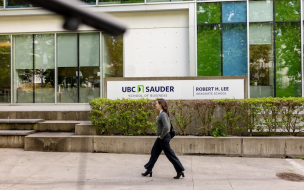Fourteen students enrolled in the GWSB Sports Management Program had the opportunity to study international baseball recruiting practices in the Dominican Republic last month.
Students travelled throughout the Dominican Republic – the major hub where Major League Baseball (MLB) goes to scout talent – visiting MLB academies and speaking with talent scouts, players and team personnel about recruiting practices.
Part of the “Baseball Scouting, Development and Impact” class taught by Dr. Lisa Delpy Neirotti, the goal of the trip was to explore the importance of the DR in term of international scouting and developing.
“We wanted to understand why all 30 MLB teams have established academies and sent personnel to work in the DR”, explains Dr. Neirotti, “and found out that baseball is the only sport that all these kids play. Clearly, when you focus on one sport you’re more likely to be good at it, as is Brazil with soccer. Dominicans practice baseball, play it, watch it, and dream about it, thus making the DR a great ground for scouts”.

The Pittsburgh Pirates are maybe the best example of what happens to teams that don’t scout in the right places. The baseball team has lost 18 seasons since 1992, mainly because “they were not scouting where everybody else was,” says Charles Reynolds, one of the GWSB MBA students who participated in the trip. In 2007 the Pirates decided to invest $5million in a new training academy in the DR, he points out.
Thanks to the many high-level connections GWSB has with MLB teams, the students had the opportunity to visit thirteen academies and worked on different projects covering all the main issues facing the Dominican baseball system. Alumni of the GW School of Business include President of the New York Yankees, Randy Levine, owner of the Chicago White Sox, Jerry Reinsdorf, and owner of the Washington Nationals, Mark Lerner.
Buscones and player development

One of the most important issues is the role of buscones, unofficial agents who scout for players. In the absence of a register, nobody knows how many buscones there are in the DR, although Dr. Delpy Neirotti estimates that there are almost 3,000.
One of the students on the trip, Richie Peterson, decided to build a database to classify them: “I spoke with John Seibel, who is a consultant with the MLB in the DR and we thought that a database with all the buscones, and the players they are training or have trained in the past, would be helpful especially to figure out which buscones are the most successful”. Richie is now writing a proposal to send to the MLB: if it is approved, he’ll go back to the DR to build the database.
Developing young talent

Chris Watt’s project was to understand the player development systems and the organizational structures of the MLB academies. He studied the Dominican Summer League and compared how different club's strategies in DR differed from their operations in the US. “Since 25% of the MLB rosters are players of Dominican descent, the talent level is almost unmatched”, he explains, “But each team has a different method to develop the players athletically, academically, and culturally, and I wanted to see the correlation between the development methods and the success rate of MLB clubs having Dominican players”.
Chris found out that there is significant variation between how the thirty MLB clubs run their DR operations: “Some organizations spend a significant amount of time creating player development plans for each individual player from the time they are taken into their system at age 16, with complete synergy between their US and DR operations. Others have the goal to bring players to the US immediately, so they teach them the fundamentals and send them through the system as soon as they can. Both systems have proven to be successful and research is underway to find out the most efficient method”.
“Academies are really different”, adds Dr. Delpy Neirotti, “Some are beautiful, like the one of the San Diego Padres that cost between US$8 and $12 million, while some have older facilities. Some have extensive education programs, while some just focus on baseball and basic English class”.
Social responsibility
Amy Trout Hughes, 43, focused on the academies’ corporate social responsibility practices: “The baseball academies could do more, and from the conversations we had with their staff, it seems that they are aware of it”, she says commenting on the academies’ impact on the Dominican community, “What strikes me is the lack of coordination of all the efforts, whether they come from the US government, from international or individual non-profits, or from local NGOs. Because of it, their impact is limited”.
International draft
Students are also working on an alternative to the international draft that the MLB wants to extend to Dominican players. At the moment, Dominican players are exempt from this draft and can sign with MLB teams as free agents when they turn 16. Nationalities included in the draft, such as Puerto Ricans, instead, have to wait until they graduate from high school or they turn 18, and find themselves in competition with American players.
“The international draft would make the MLB happy, by bringing down bonus amounts”, explains Charles Reynolds, “However buscones, who at the moment sign players for a million dollars, will lose an important incentive.” Therefore, the students are working on a draft system that would keep buscones and the other stakeholders happy.
Looking at baseball anew
All the students were enthusiastic about the experience: Charles feels he “learned more in those eleven days than in any traditional class” he has taken.

Amy Trout Hughes, who has always been a big baseball fan, says the trip changed the way she looks at the sport. “I’m not the pure fan that I was”, she explains, “I’ve always seen it as entertainment, and so to see that baseball in the DR opens opportunities and is seen as a lifetime goal for these children and their family is a bit overwhelming. It was an eye-opening experience.”

“It was interesting to see how important baseball is for their culture”, confirms Richie Peterson, “In the US it’s not even the most popular sport anymore. These kids play with plastic bottles and a wooden stick in the street, hoping that one day it’ll make them big, and provide their family with money.”
“Before I went to the DR I thought that the buscones were taking advantage of these kids”, he continues, but they are actually providing a pretty valuable service for them: they take them in when they’re 13, provide them with food, housing and food till they’re 16 and can sign a contract. This was the most interesting and enlightening thing I learnt while I was there”.

RECAPTHA :
67
bb
c4
fc







